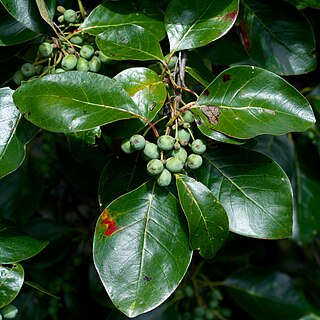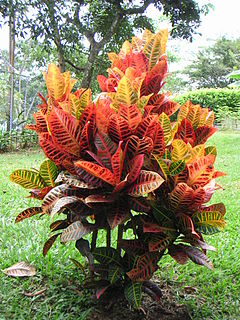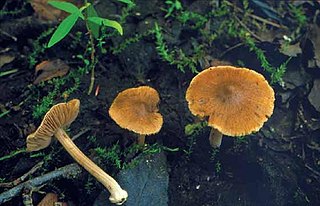
Nyssa sylvatica, commonly known as tupelo, black tupelo, black gum or sour gum, is a medium-sized deciduous tree native to eastern North America from the coastal Northeastern United States and southern Ontario south to central Florida and eastern Texas, as well as Mexico.

Hoya is a genus of over 500 accepted species of tropical plants in the dogbane family, Apocynaceae. Most are native to several countries of Asia such as Philippines, India, Thailand, Malaysia, Vietnam, Bangladesh, Indonesia, Polynesia, New Guinea, and vast variety of species could also be found in Australia.

Tiger snakes are a large and highly venomous snake of southern Australia, including its coastal islands and Tasmania. These snakes are often observered and locally well known by their banding, black and yellow like a tiger, although the species can be highly variable in coloration and patterning. All populations are classified within the genus Notechis (Elapidae), their diverse characteristics have been classified either as distinct species or by subspecies and regional variation.

Taxodium distichum is a deciduous conifer in the family Cupressaceae. It is native to the southeastern United States. Hardy and tough, this tree adapts to a wide range of soil types, whether wet, salty, dry, or swampy. It is noted for the russet-red fall color of its lacy needles.

Moses Harris was an English entomologist and engraver.

A parabolic aluminized reflector lamp is a type of electric lamp that is widely used in commercial, residential, and transportation illumination. It produces a highly directional beam. Usage includes theatrical lighting, locomotive headlamps, aircraft landing lights, and residential and commercial recessed lights.

Alcea rosea, the common hollyhock, is an ornamental dicot flowering plant in the family Malvaceae. It was imported into Europe from southwestern China during, or possibly before, the 15th century. William Turner, a herbalist of the time, gave it the name "holyoke" from which the English name derives.

Codiaeum variegatum is a species of plant in the genus Codiaeum, which is a member of the family Euphorbiaceae. It was described by Carl Linnaeus in 1753. It is native to Indonesia, Malaysia, Australia, and the western Pacific Ocean islands, growing in open forests and scrub.

Nepenthes flava is a tropical pitcher plant endemic to northern Sumatra, where it grows in montane forest at 1800–2200 m above sea level.

Nepenthes leonardoi is a tropical pitcher plant known from a single locality in central Palawan, the Philippines. It is closely allied to several other Palawan endemics, including N. deaniana, N. gantungensis, and N. mira. The traps of this species reach at least 24 cm in height. Some specimens are noted for producing very dark, almost black, upper pitchers.

Metridium senile, or frilled anemone, is a species of sea anemone in the family Metridiidae. As a member of the genus Metridium, it is a type of plumose anemone and is found in the seas off north-western Europe and both the east and west coasts of North America.

Astropecten platyacanthus is a sea star of the family Astropectinidae.
Lactarius torminosulus is a member of the large milk-cap genus Lactarius, in the order Russulales. A European species, it was officially described in 1996 from collections made in Norway. Fruit bodies (mushrooms) are small to medium-sized, yellowish orange in colour. Young specimens have a hairy cap margin; these hairs slough off in maturity—a field characteristic that can be used to help distinguish this species from the similar Lactarius torminosus. The fungus grows in a mycorrhizal association with dwarf birch species.

Inocybe saliceticola is a fungus found in moist habitats in the Nordic countries. The species produces brown mushrooms with caps of varying shapes up to 40 millimetres (1.6 in) across, and tall, thin stems up to 62 mm (2.4 in) long. At the base of the stem is a large and well-defined "bulb". The species produces unusually shaped, irregular spores, each with a few thick protrusions. This feature helps differentiate it from other species that would otherwise be similar in appearance and habit.

Ricordea florida is a species of coral of the family Ricordeidae and the order Corallimorpharia, whose members are also called false corals. Due to their bright pigmentation and fluorescence under ultraviolet light, Ricordea florida is very popular in hobby saltwater aquariums.

Crassula ovata, commonly known as jade plant, lucky plant, money plant or money tree, is a succulent plant with small pink or white flowers that is native to the KwaZulu-Natal and Eastern Cape provinces of South Africa, and Mozambique; it is common as a houseplant worldwide. Much of its popularity stems from the low levels of care needed; the jade plant requires little water and can survive in most indoor conditions. It is sometimes referred to as the money tree; however, Pachira aquatica also has this nickname.

Leucospermum heterophyllum is a low, trailing evergreen shrublet of up to 15 cm (6 in) high, and up to several m in diameter, which is assigned to the family Proteaceae. It has narrow leaves of about 2½ cm (1 in) long and ½ cm (0.2 in) wide, mostly with three teeth near its tip. It has small, globe-shaped, whitish flower heads. It is called trident pincushion in English and rankluisie in Afrikaans. It naturally occurs in the Western Cape province of South Africa. The plant flowers between August and January.

Mariannaea elegans an anamorphic fungus. It is mainly found on rotting wood and soil. M. elegans is not pathogenic to humans, animals, or plants.

Tibouchina lepidota, also known as alstonville, Andean princess flower, lasiandra, or glory bush, is a medium-sized ornamental tree or a large shrub native to northwestern South America that is cultivated for its masses of purple flowers from autumn right through to winter.

Protea effusa, sometimes known as the scarlet sugarbush, is a flowering plant which belongs to the genus Protea. The plant is endemic to the Western Cape province of South Africa. In the Afrikaans language the vernacular name blosrooisuikerbos has been recorded for this plant.



















